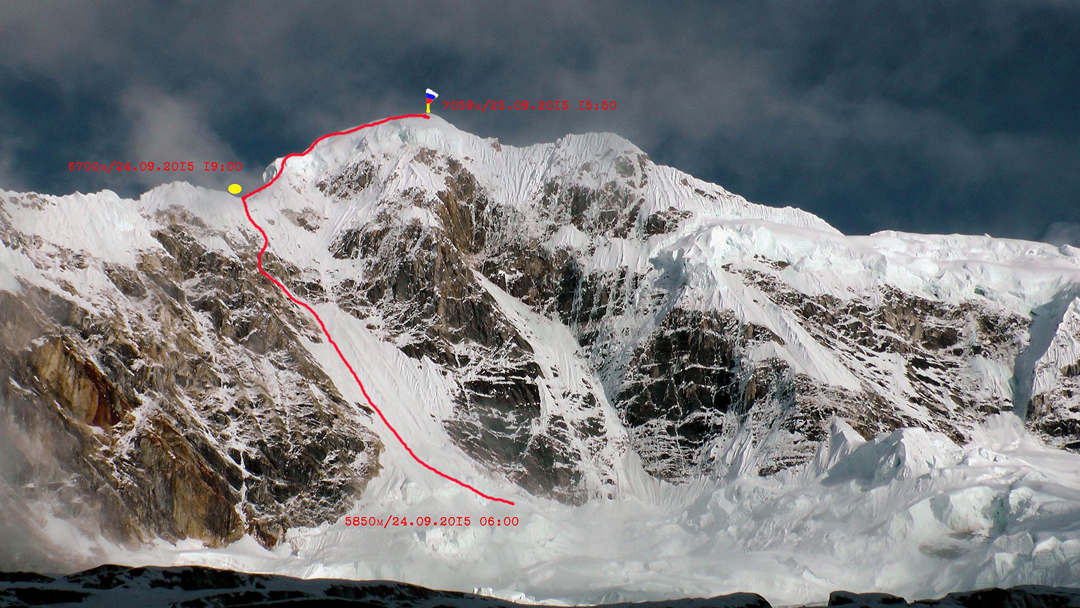Thulagi, West Face and Northwest Ridge, Happy Birthday
Nepal, Manaslu Himal
 I’ve been thinking about how to write this report so that you will not be bored. Apart from a small incident with an avalanche, everything went to plan, and we achieved our goal without epics. But I will try to stop you from falling asleep.
I’ve been thinking about how to write this report so that you will not be bored. Apart from a small incident with an avalanche, everything went to plan, and we achieved our goal without epics. But I will try to stop you from falling asleep.
There had been six previous attempts to climb Thulagi (7,059m). Several of these had tried from the north, and some of our team had been on one of those unsuccessful expeditions, so we were not interested in that approach. Belorussians Nikolay Bandalet and Sergei Belous had tried the south face, approaching from the southeast via the long and convoluted Thulagi Glacier, but tragically disappeared (AAJ 2012). Ivan Dozhdev, Rusian Kirichenko, Valery Shamalo, and I decided to try from the southwest, where there is a glacier flowing down from Thulagi below Phungi (6,538m) to the northwest.
On September 10 we reached base camp at 3,665m in a government rest house at Dharmasa. Porters explained how to get onto the glacier above, but we found it hard to believe them—the slopes looked steep, with rock climbing that could hardly be termed “an approach.” However, we found a canyon that proved to be relatively straightforward, and above it a grassy path led almost to the glacier, where we found a comfortable place for an intermediate camp at 4,700m. Despite bad weather, on the 13th we cairned a route to the glacier at ca 5,100m, and the next morning went to inspect the mountain. We were surprised to find an old rope running through a crevasse and a package of gas cartridges. Who had they belonged to and where had they been going?
There were several options, on the left and right side of the face, but we decided to go left, where the glacier seemed quite passable. A day or two later, we established an assault camp at 5,750m, setting it carefully below a deep crevasse that would catch all possible avalanche debris. We then descended to base for a rest.
Imagine our surprise when we returned to find our high camp demolished. An avalanche had come from the wall above, and the tent had been exactly in the middle of its flow—10m right or left and it would have been untouched. The tent was destroyed. Most of the gear inside was fine, but our ice tools, which had held it down, were gone. After a diligent search the next day we found three tools, which would be enough for four people if we took the easiest line.
We set off on the 24th in beautiful weather, with three days’ food, two sleeping bags, and a small frameless tent. We climbed 14 pitches in 11 hours that day, including three on very loose rock and the rest on ice (55–70°). This brought us to the northwest ridge at 6,700m, where we dug a small snow cave for the night. Next day, taking only ice gear and a couple of ropes, we raced up the ridge. There was a section of vertical ice on the upper serac, after which we dropped ropes and gear and plodded to the summit. It was Ivan’s 29th birthday, so we let him be first to step onto the top. We reversed the route, spending a second night in the snow cave, and were back at base on the 27th. We named our route Happy Birthday (1,200m, 1,850m of climbing, Russian 6A, TD+ AI4+ 5c M4).
Alexander Gukov, Russia, supplied by Anna Piunova, Russia




